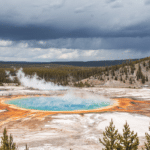1. Niamey

Niamey, the capital of Niger, is a lively fairly modern city of around 800,000 on the banks of the Niger River in the Tillaberi region in the far southwest of the country. It is the administrative, cultural and economic centre of the country and hence generally offers good facilities for travellers, both budget and upmarket. Niamey offers unique open-air markets that are great for people watching—they’re patronized by members of the Tuareg Sonuri and Fulani tribes, as well as wrestling, one of the finest museums in Africa and the massive Grand Mosque.
2. Agadez

On the southern fringe of the Saharan desert, Agadez was founded in the 15th century and became a thriving stop along the route of medieval trading caravans. The nomadic Touaregs settled the city while maintaining the boundaries of historical encampments, forming a street pattern that exists to this day. It’s renowned for its earthen architecture; an 89-foot minaret made entirely of mud is the tallest of its kind in the world.
3. Lake Chad

Chad has always been some place where travellers wave goodbye to their comfort zone and say hello to adventure. Even when it is safe to visit, which sadly it is currently not, the art of travel here is demanding in every sense of the word. This, though, is part of the country’s allure, an opportunity to break emphatically away from all that you know, and come to a place that promises experiences, good and bad, that happen nowhere else. But if Chad is such a demanding place to travel, why ever bother?
Picture sublime oases hiding in the northern deserts, stampeding herds of wildlife running through national parks and deep blues awaiting boats on Lake Chad – put simply, when Chad is accessible it’s a country and an experience that can never be forgotten.
4. Zinder

Zinder, city, south-central Niger. The country’s second largest city, it was the capital of a Muslim dynastyestablished in the 18th century, which freed itself from the sovereignty of Bornu in the mid-19th century. The city was occupied by French troops in 1899, and it served as the capital of the former French colony of Niger (in French West Africa) from 1922 to 1926.
Zinder lies in the centre of an important peanut- (groundnut-) producing region and is a major processing centre and market, with a peanut-processing mill, a millet-flour mill, a tannery, and a thermoelectric-power plant. The city is situated at the border of regions populated by sedentary Hausa farmers and nomadic Fulani. Zinder lies at the crossroads of the main east-west road through Niger and the north-south route from Agadez to Kano, Nigeria.
5. Diffa

Diffa is a city and Urban Commune in the extreme southeast of Niger, near that country’s border with Nigeria. It is the administrative seat of both Diffa Region, and the smaller Diffa Department. As of 2011, the commune had a total population of 48,005 people. Diffa marks the eastern end of the paved section of Route Nationale 1, the main east west highway across Niger, although the section between Zinder and Diffa is only partially paved in places. RN 1 continues north to N’guigmi more than 100 km. Maïné-Soroa, the other major town of the Region, lies less than 100 km to the west of Diffa. The border with Nigeria, at the Nigerian town of Duji, is 5.5 km to the south of Diffa. Diffa Airport lies to the north of the town.
6. Dirkou

Dirkou is a town in the Bilma Department, Agadez Region of north-eastern Niger. It lies in the northern Kaouar escarpment, a north-south line of cliffs which form an isolated oasis in the Sahara desert.
7. W National Park

The park includes areas of three countries: Niger, Benin and Burkina Faso, and is governed by the three governments. The three national parks operate under the name W Transborder Park.
The W National Park of Niger was created by decree on 4 August 1954, and since 1996 has been listed as a UNESCO World Heritage Site. Within Niger, the Park is listed as a National Park, and is part of a larger complex of Reserves and protected areas. These include the adjacent Dallol Bosso Wetlands on the eastern bank of the Niger and the partial overlap of the smaller Parc national du W.


